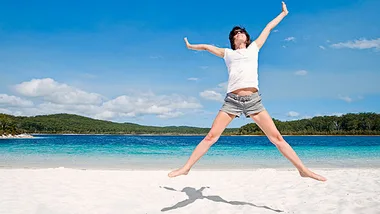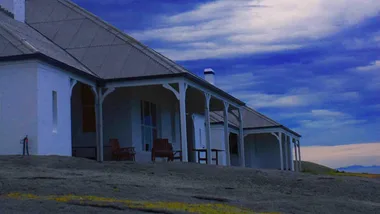As I took the plunge with mask and snorkel, the turtle looked me in the eye as if to say, “Come on, mate, I haven’t got all day to show you around the bay”, before gently swimming off in the direction of Sylph’s Hole, a coral crater half way across the bay.
Lord Howe’s wild beauty ranks it among the most alluring islands in the South Pacific. And it’s so close to Australia’s East Coast, you can breakfast in Sydney or Brisbane and swim with turtles in its limpid waters before lunch.
Old Settlement Beach is a favourite turtle haunt and soon after my arrival, I strolled down to the water’s edge to find one floating two metres offshore, head poking out of the water as if in greeting.
Turtles can swim at 20kph. That’s faster than Ian Thorpe, who’s been known to reach 8kph over 400m, which proves the turtle in question could have disappeared in a jiffy if it had so wished.
Instead, I followed it around the bay as it nibbled sea grass and glided gracefully past lion fish and spangled emperors swimming among the purple-tipped antler coral.
World Heritage listed in 1982, Lord Howe has more wildlife than people – 370 residents and no more than 400 visitors at any one time, compared with the hundreds of thousands of seabirds that arrive to breed. Fourteen species lay their eggs on the island – on precipitous cliff ledges, in earthy burrows inland, on the pastures usually reserved for cows and precariously on branches in the pisonia forests.
Stray too close to a nesting colony of sooty terns on Malabar Hill and you’ll find yourself in a scene from Alfred Hitchcock’s film The Birds. Relentlessly, the terns dive bomb intruders until they retreat. Be warned this is a confrontation you cannot win.
Back at Old Settlement Beach, the turtle eventually changed gear and shot off towards the reef, which, according to oceanographers, is the world’s most southerly coral reef. Bathed by the warm waters of the East Australian Current, which sweeps down from tropical Queensland, the reef is home to 500 fish species and 90 types of coral.
A few minutes stroll from the beach is Arajilla Retreat, one of Lord Howe’s most intriguing properties. Surrounded by a ‘cathedral’ of giant banyan trees filled with bird song, this timber and glass sanctuary has 12 pavilions spread around a remnant forest.
The main building – with restaurant and lounge area – is made up of a long crimson feature wall, decorated with Balinese sculptures and soft furnishings. Three plate glass walls give views over a fern garden. It’s an elegant space, where you can dine on freshly caught fish and other local produce.
You would never guess that the resort’s 22 queen-sized beds had been tossed on the ocean waves on “a 400-mile blue water marathon” before arriving in the bedroom suites. Resort owner Bill Shead brought the beds from the mainland strapped to his 17-metre catamaran, Cut Loose. “That’s a lot of effort to create comfort,” says Bill, who has sailed 45,000 miles back and forth between Lord Howe and the mainland. Freight charges, he says, are exorbitant.
Arajilla is perfectly positioned to explore the north of the island along two walking trails. The well-defined path crosses a style at the far end of Old Settlement Beach and then climbs 182 metres up hundreds of wooden steps. Just before the summit, the trail splits into two. Take the left to Mount Eliza and the right to Kim’s Lookout. The views from Mount Eliza and the Lookout take in the entire island, including its emerald forests, crescent-shaped sandy beaches and mesmerising lagoon, an ever-shifting patchwork of turquoise and aquamarine, whch meets the basalt cliffs of Mount Lidgbird and Mount Gower at the southern tip of the island.
After Kim’s Lookout, the trail winds along the cliff-tops, where red-tailed tropic birds can often be seen using the thermals to fly backwards in a bizarre courtship ritual, and then continues to Malabar Hill and Ned’s Beach, where fish are so numerous scenes from the bible come to mind.
Those who like to have the luxury of a room with a view should stay at Capella Lodge on the south of the island, next to Lovers Bay. Here Mount Lidgbird and Mount Gower dominate the outlook from Capella’ terrace and dining room. Besides its spectacular location, the lodge is famous for its exquisite food, courtesy of chef Phil Woolaston, formerly of Finns, Byron Bay.
On my first visit to Lord Howe Island, I missed having lunch at Capella, thanks to a Lord Howe wood hen. At the time, the wood hen faced extinction. There were only six breeding pairs left in the world, all of them on Lord Howe, and as I rode a bicycle to Capella that day one of them attempted to cross the road. Swerving to avoid it, I broke my arm when the bike skidded and overturned on some gravel.
Luckily, Lord Howe has a small hospital. Phil wasn’t cooking in Capella’s kitchen at the time, but I was told later I had missed an excellent lunch.
There are two walks conveniently close to Capella. The easy one follows the old track, past crescent beaches and groves of kentia palms, to the base of Mount Gower. The other is an eight-hour climb to the summit of Mount Gower with Jack Shick, a fifth generation local and one of the few people certified as a guide into this restricted area. The summit has been called a “lost world” where several species of plant, found no where else in the world, thrive.
Between March and September, providence petrels soaring above Mount Gower can be to “called down” by making any continuous loud sound as they return from an afternoon fishing out at sea. Attracted by the sound, the birds land all around the callers and, having no fear of humans, can be picked up.
On my last night at Capella, our feast of lamb loin, soft polenta and sugar snap peas was interrupted by a disturbing shriek from the valley below. “That’s a Lord Howe wood hen looking for love,” said Capella’s manager Libby Grant. I couldn’t help thinking out loud whether it was the same bird that laid me low on my last visit. “Could be,” replied Libby. “It’s one of the rarest birds in the world and that particular one has no road sense at all,” she added with a twinkle in her eye.
Lord Howe Island, NSW, www.lordhoweisland.info; www.tourism.nsw.gov.au. Arajilla, 1800 063 928; www.arajilla.com.au. Capella Lodge, (02) 9918 4355; www.lordhowe.com. QantasLink, 13 13 13; Qantas.com.



